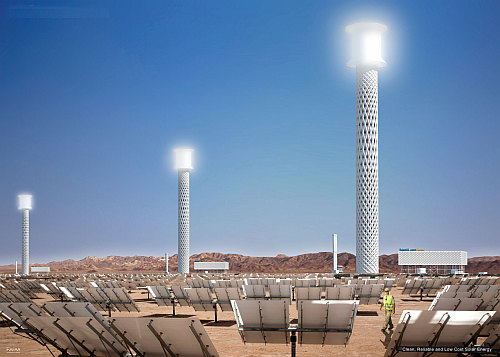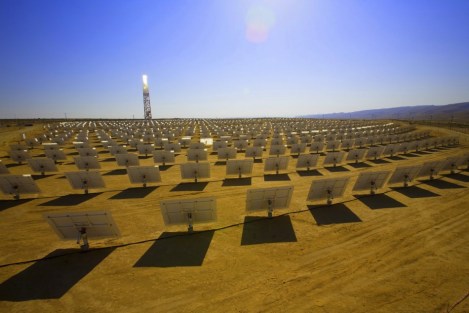Over the last year or so, Republicans have woven a tale of collapse and futility around clean energy. Each setback for the industry, each bankruptcy or refinancing, is met with open glee, plastered all over Fox News for weeks on end. In the first presidential debate, Mitt Romney said to Obama, “you don’t just the pick the winners and losers — you pick the losers.”
I can’t recall ever seeing a major political party rooting for the failure of a growing American industry like this. Is there any precedent? I guess asymmetrical polarization has brought us to uncharted territory.
It’s worth remembering, as Mike Grunwald documents so well in his new book The New New Deal, that Mitt Romney is full of sh*t. Obama’s clean-energy programs have been a rousing success, driving a doubling of wind and solar capacity with vanishingly little fraud and fewer failed investments than Congress budgeted for.
It’s easy to say that, even to document it, but what clean energy really needs is a money and media infrastructure with as much muscle as the one devoted to destroying it, a network that can circulate success stories and push them into mainstream media with as much frequency and success as the fossil-fuel groups that have Politico by the short hairs.
As an obscure Dirty Blogger, I can’t provide that, but I can do my part. So let’s take a look at a clean-energy success.
In April of last year, the Ivanpah solar project (developed by BrightSource Energy) got a $1.6 billion loan guarantee from DOE. Ivanpah will be a solar-thermal power plant that uses heliostat mirrors to concentrate sunlight on fluid in “solar power towers,” which then provides steam to run turbines.
To quote myself:
[Ivanpah] is technically three separate, contiguous power plants, built in phases, with a total of 170,000 heliostat mirrors, spread across 3,600 acres, aiming sunlight at three solar power towers. It will have a gross capacity of around 392 megawatts and will be, when completed, the largest [concentrating solar power] installation in the world.
According to the company, the plant is on schedule to open in 2013. It’s about 70 percent finished and currently employing 2,100 on-site workers. (“Green jobs,” I believe they’re called.)
It seems that DOE’s bet on Ivanpah did exactly what it was supposed to do: help BrightSource demonstrate the viability and market value of its product. Now the company has had two bits of good news.
First, yesterday it secured more than $80 million in new private equity financing, bringing its total to $615 million. In a press release, the company says the additional money comes via “Alstom and VantagePoint Capital Partners. Additional investors include DFJ, DBL Investors, Goldman Sachs, Chevron Technology Ventures, CalSTRS and BP Ventures among others.” (Thanks, Chevron!)
And second, later in the day the California Public Utilities Commission (CPUC) unanimously approved two of BrightSource’s new contracts with Southern California Edison. That brings its total CPUC-approved contracts to 10, three with Southern California Edison and seven with PG&E.
The CPUC rejected three other BrightSource contracts as too expensive. What made the difference in the two that were approved is energy storage.
The Sonoran West project in Riverside County, which is expected to produce 733,000 MWh a year, will have a two-tank molten salt system. Super-heated salt is kept in one tank, cooler salt in the other. To store energy, steam generated in the solar power tower is used to heat salt, which is stored in the first tank. When power is needed (and the sun isn’t shining), the hot salt passes through a heat exchanger to the second tank, leaving behind steam to run a generator. (The other project, the 573,000-MWh-a-year Rio Mesa plant, was judged by CPUC to have technology that is “a necessary precursor” to solar-thermal systems with storage.) The CPUC is keenly interested in pushing storage technology; it’s going to need it to meet California’s aggressive renewable energy targets.
Solar thermal with storage is still expensive. On a per-MWh basis, even solar PV beats it. But it has the great advantage of being zero-carbon power that is not intermittent, unlike wind and solar PV. Storage allows it to a) serve as “firm” power, displacing rather than supplementing fossil fuel plants, b) act as “spinning reserve,” backing up intermittent plants, and c) shift electricity generation to times of highest demand, thus displacing the most expensive fossil-fuel power. Those extra services are not always compensated, or compensated in a rational way, in current power markets. In this case, as usual, California will blaze a trail and learn lessons that will go on to benefit the rest of the country.
In the short-term, the two contracts CPUC approved yesterday will, according to BrightSource, yield more than 2,000 construction jobs, more than 1.3 million MWh a year, 400,000 tons of avoided CO2 emissions annually, and billions of dollars infused into the California economy.
In the long-term, the fastest way to drive down the cost of solar thermal power is to commercialize and deploy it. A DOE loan guarantee helped BrightSource begin scaling up in earnest. It now has 9 GW worth of solar power plants either planned or built in the U.S. Southwest. More importantly, it has a serious foothold in a market that is destined to grow exponentially larger.
Yes, there are better clean-energy policies than DOE loans to individual companies. A national Renewable Energy Standard, say. Or feed-in tariffs. Or a quadrupled federal energy R&D budget. Or a stiff carbon tax. Or all of the above! But the clean-energy programs that Obama was able to put in place are working. An industry is emerging, in fits and starts, despite the embarrassing spectacle of Republicans rooting against it.





